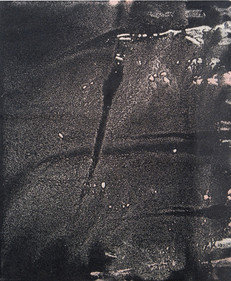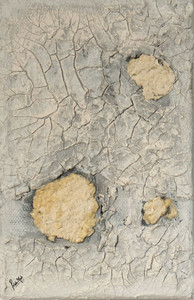Silhouettes of Shards
- Ranjan Kaul

- Sep 6
- 4 min read
Artist Palak Modi in Conversation with Ranjan Kaul

New Delhi-based visual artist Palak Modi explores the profound interplay between death, decay, and regeneration in her practice. Working with heavily textured canvases, tactile paper works, and sculptures, she delves into the fragility and resilience of the human condition.
With a background in psychology from Delhi University of Delhi, Modi brings a nuanced understanding of trauma, memory, and transformation to her deeply introspective visual language, shaped by personal experiences.
Modi's material choices—cement, ash, pulp, gauze, and sand—are intentionally raw and visceral, emphasizing the impermanence shaped by time and trauma. She has exhibited extensively, including a solo show at Gallerie Romain Rollande (New Delhi), participation in the International Contemporary Art Fair (Spain), and group shows at Dhoomimal Gallery (New Delhi) and Abir India (Ahmedabad). Her works are available on Terrain.art, a global platform for South Asian contemporary art; she has also been featured in Artsy, Abirspace, Abir Pothi, and Artsper.
Ranjan Kaul: Given that your background is psychology, what prompted you to become an artist? In what way has your academic training in psychology influenced your art?
Palak Modi: I was drawn to art long before I studied psychology, but my academic background has given me a richer lens through which I can explore the human condition. Psychology made me deeply aware of the invisible layers of experience, memory, trauma, resilience, and the way they shape perception. My practice draws on this understanding, not in an illustrative way, but as an undercurrent. I work with materials that carry weight and history, and with forms that feel both fractured and whole, mirroring the way people reconstruct themselves after rupture. In a way, my art is a tactile form of psychological exploration, where the canvas becomes a space for excavation, confrontation, and transformation.

RK: Please give a brief account of your journey as an artist. Any role models or mentors? How challenging has it been for you to emerge as an artist with a distinct visual language?
PM: I began creating as a child, but it wasn’t until my early twenties — after a life-altering accident — that my practice took on its current depth and urgency. That experience forced me to live with physical and emotional fragmentation, which eventually found expression in my work. I’ve been influenced by artists who use materiality as metaphor. Anselm Kiefer’s monumental, eroded surfaces, for example. My visual language has developed organically, through years of experimentation with form, texture, and non-traditional materials. The challenge has been resisting trends and instead rooting my work in a philosophical and material vocabulary that is wholly my own. It’s been a slow build, but that’s also what makes it authentic.

RK: What was the genesis, inspiration and motivation behind your recent solo exhibition, Silhouettes of Shards, held at Bikaner House, New Delhi? Could you briefly describe the theme of the show and what you were trying to convey through the works?
PM: Silhouettes of Shards grew out of my ongoing engagement with the ideas of death, decay, and transformation. The works were not conceived as a linear narrative, but as fragments – each holding traces of rupture, erosion, and eventual re-emergence. The title itself hints at the paradox of fragility and endurance. Through layered surfaces, scorched hues, and sculptural forms, I wanted to invite viewers into a space where destruction is not the end, but the beginning of something altered, yet alive. The show was both deeply personal and universally resonant, speaking to the ways we carry our past selves forward into new forms of being.




RK: Your works are abstract and textured with use of non-traditional materials including cement, ash, pulp, gauze and sand. Could you elaborate on the style and choice of materials? Why do you think they best depict your thematic?
PM: I gravitate towards materials that carry a visceral, almost bodily weight — cement, ash, pulp, gauze, sand because they hold within them a sense of time, fragility, and permanence. Cement cracks, ash disintegrates, gauze frays. These are processes of transformation embedded in the materials themselves. In my practice, these substances don’t just serve as mediums; they are metaphors. They allow me to physically manifest concepts of erosion, healing, and reformation. Texture becomes language – the raised, weathered surfaces invite touch and suggest histories that can’t be neatly smoothed over.
RK: Where do you create your art? Could you describe your process in some detail?
PM: I work out of my studio in New Delhi, a space where I can immerse myself fully in the act of making. My process is layered and intuitive. I begin by creating a base that already holds depth and texture, then gradually build upon it through repeated interventions. I work slowly, often stepping back for days before returning with a fresh eye, allowing the piece to evolve in its own time. The process is less about executing a fixed vision and more about engaging in an ongoing dialogue with the work until it feels complete. I build the surface layer by layer, carving back into it, burning, adding, and reconfiguring until the work feels like it’s holding its own internal history. It’s an intuitive, almost archaeological process, I’m uncovering and constructing at the same time.



RK: How would you situate your art in the post-modern, contemporary art landscape?
PM: My work is rooted in contemporary concerns – impermanence, resilience, the relationship between material and meaning – but it resists purely conceptual detachment. It’s tactile, process-driven, and invested in the physicality of making. I see my practice as part of a larger conversation about repair and transformation, a counterpoint to the disposable, instantaneous tendencies of our time. It belongs to a lineage of artists who use abstraction and materiality to address deeply human experiences, without reducing them to literal representation.
RK: Tell us about any other interest you may have besides your art practice. Does it get reflected in your art?
PM: Beyond my practice, I enjoy reading, especially books related to psychology and human behaviour. These explorations often influence how I think about my work - the themes of trauma, resilience, transformation, and the layered nature of experience are ideas I return to repeatedly in my art.

(All images are courtesy of the artist Palak Modi.)

Ranjan Kaul is a visual artist, art writer and critic, curator, author and Founding Partner of artamour. His works may viewed on www.ranjankaul.com and his insta handle @ranjan_creates.














Comments